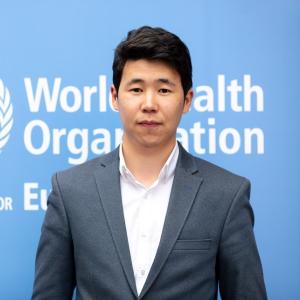New joint MOH and WHO survey: 55% of the Kyrgyz population express strong or some willingness to get vaccinated
06 April 2021
Bishkek, Kyrgyzstan: The Ministry of Health and Social Development of the Kyrgyz Republic jointly with WHO has released findings of the latest assessment of the experience and perception of COVID-19 by the people in Kyrgyzstan. This assessment was conducted with technical and financial support from WHO and the United States Agency for International Development (USAID). It took place in three rounds between December 2020 and February 2021. Results are meant to inform the COVID-19 response and will provide a strong foundation of evidence to guide policies, messaging and communication campaigns.
The assessment is rapid, flexible, cost-effective method of monitoring of public awareness, risk perception, behavioural patterns and confidence levels; the results allow policy makers to adapt COVID-19 response measures and increase their effectiveness.
The data was collected through computer-assisted telephone interviewing (CATI), which covered 1,000 people from seven regions of Kyrgyzstan and two main cities of Bishkek and Osh in each round of data collection. The data collection was supervised by the KR Ministry of Health and Social Development which owns all the data collected under this Project.
"The survey is important because it helps us understand the willingness of people to get vaccinated. We have to realize that today vaccination is one of the main protective measures that can control the pandemic and reduce the numbers of new and fatal cases", said Nazira Artykova, WHO Representative in Kyrgyzstan.
“It is no secret that one of the important elements to reduce the level of transmission of the virus is the behaviour of the population. To effectively fight the epidemic, we need to change the paradigm of behaviour, lifestyle and habits. Such behavioural studies will help to build effective measures to combat COVID-19, as well as identify key points of influence on human behaviour and relevant channels for communicating information. The results of the study will lead to changes in the communication strategy for vaccination", says Bakyt Dzhangaziev, Deputy Minister of Health and Social Development of the Kyrgyz Republic.
Using the findings highlighted below, the MOH is considering ways to focus on recommended actions:
VACCINATION
- Higher levels of uncertainty about the vaccine, lower rates of confidence in its effectiveness, and support for the national vaccination calendar raise concern. Hesitancy about vaccines is higher than in the previous stages of data collection: 55% of the Kyrgyz population express strong or some willingness to get vaccinated.
Recommended actions: Ensure all people have sufficient information about the vaccines that are available; as more people are vaccinated, share their stories widely so the public can hear from those with direct experience; consider a special focus on encouraging health workers to get vaccinated themselves and advocate for vaccination broadly.
KNOWLEDGE/INFORMATION
- Just over half of the respondents believe that they are well-informed about the vaccine (52%) and understand the vaccine recommendations (54%). As with COVID-19 issues in general in the past, the most difficult aspect (40%) was assessing the reliability of information about the vaccine in the media.
- It is possible to note lower levels of health literacy in comparison with the 1st and 2nd rounds. The awareness of the Kyrgyz population about what to do when COVID-19 is suspected has decreased from 69% to 63%, and the share of those who can find the necessary information has decreased from 64% to 59%.
Recommended actions: Review messaging and information materials to ensure they are understandable to the target populations, revise and disseminate information as necessary; consider testing messages with target audiences; engage with community leaders to provide support for information sharing through social networks (in-person and through social media)
RISK PERCEPTION AND PROTECTIVE BEHAVIOURS
- There are no significant changes in the risk perception level and almost half of the respondents still believe that infection is unlikely and/or will not occur in a severe form. The overall level of risk perception has remained unchanged since the beginning of data collection. There is a slight increase in the share of people who consider low probability of infection (from 42% to 45%).
- Practicing protective behavioural models generally remains below the desired levels and serves as a risk factor for a re-outbreak of COVID-19. At the same time, a slight decrease was recorded in the self-reported use of face masks (from 79% to 75%) and physical distancing (from 64% to 60%). The majority of respondents reported that they still do not stay at home when they get sick (49%) and do not abstain from attending social events (36%).
- Up to 18% of respondents report that they have used antibiotics to prevent or treat COVID-19 (similar to rounds 1 and 2).
Recommended actions: Using appropriate channels, language and visuals, emphasize the importance of protective behaviours, including event after receiving vaccination, and the presence of COVID-19 in the country.
###
Full versions are available in Russian: 1 round, 2 round, 3 round
For more information please contact:
Akbar Esengulov, WHO Country Office in Kyrgyzstan, esengulova@who.int
Jyldyz Aigerchinova, MOH, jyldyztynybekovna@gmail.com


